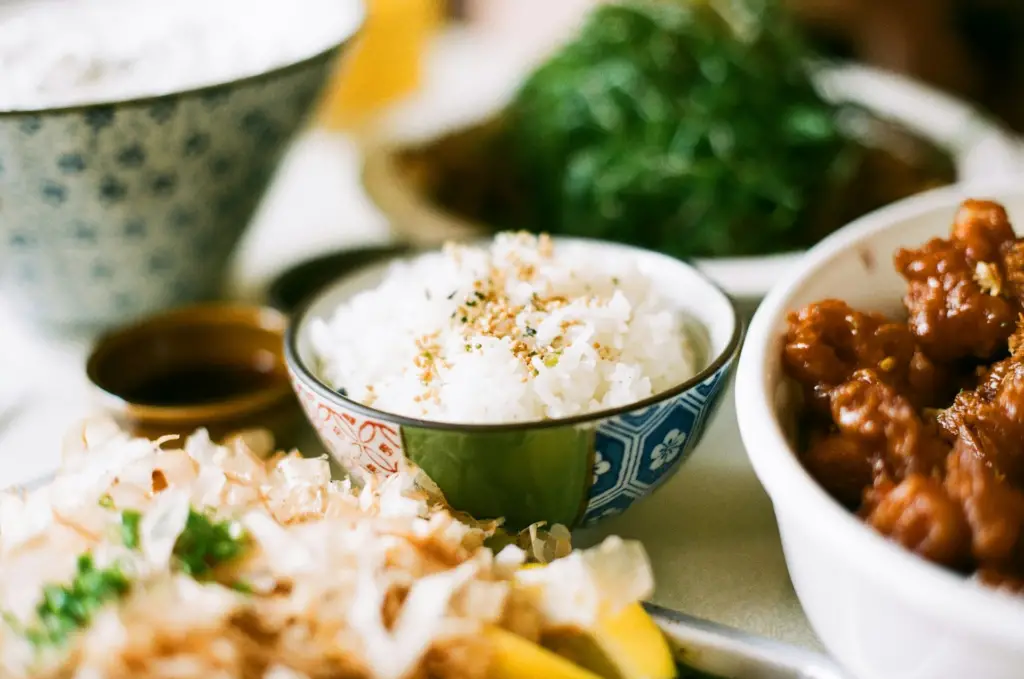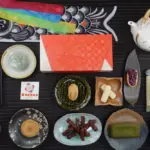Rooted in ancient Japanese culture, Kaiseki is a culinary tradition that combines artistry and tradition of Japanese food to create a unique dining experience.
In this article, we will explore the art of kaiseki cuisine and its distinct characteristics.
Let’s dive into it!
Key Takeaways
- Kaiseki is a traditional Japanese dining experience that focuses on balance and harmony. It is a culinary journey that tells a story through its meticulous preparation and presentation.
- The standard courses of a kaiseki meal are sakizuke/zensai (appetizers), suimono (1st soup course), hassun (seasonal platter), mukozuke/otsukuri (sashimi plate), takiawase, futamono (2nd soup course), yakimono, nimono, shokuji, and mizugashi or mizumono.
- Each course in a kaiseki meal represents the changing seasons, offering a visually stunning and delicious feast for the senses.
- The heart of kaiseki cuisine lies in using fresh, local ingredients. The emphasis is on quality and seasonality, ensuring that every dish bursts with flavor.
- Kaiseki is deeply rooted in Japanese culture and tradition. It draws inspiration from the tea ceremony, incorporating elements of mindfulness, simplicity, and respect for nature.
What Is Kaiseki Cuisine?
Kaiseki (懐石) is a traditional cuisine in Japan that showcases culinary artistry and fresh ingredients. It is often considered the haute cuisine of Japan.
It originated in Kyoto and is deeply rooted in the country’s culinary traditions. Kaiseki is a multi-course meal that’s prepared and presented with great care and attention to detail.
In a kaiseki, you can expect a sequence of meticulously prepared dishes, each offering a unique combination of flavors, textures, and cooking techniques.
The menu is carefully curated to reflect the season and the freshest ingredients available. The chef’s expertise and creativity are on full display as they transform simple ingredients into culinary masterpieces.

Where Can I Experience Kaiseki?
Many Ryokans (traditional Japanese inns) offer kaiseki meals as part of their accommodation package, where guests can enjoy a luxurious dining experience.
The kaiseki meal served in a ryokan often reflects the regional cuisine and local specialties of the area, incorporating seasonal and fresh ingredients. It is typically served in a private dining room or in the guest’s room, creating a personalized and intimate experience.
Kaiseki can also be enjoyed in high-end traditional Japanese restaurants called kaiseki-ryoriya. These restaurants specialize in serving kaiseki meals and often require reservations in advance due to limited seating.
Kaiseki-ryoriya establishments can be found in major cities, especially in areas known for their culinary scene, such as Tokyo, Kyoto, and Osaka.
Some luxury hotels and resorts in Japan may offer kaiseki meals as part of their dining options or as part of a special package. These establishments aim to recreate the refined and elegant kaiseki experience for their guests.
Remember that Kaiseki meals can be quite expensivedue to the high level of skill, effort, and artistry that goes into their preparation. Therefore, they are typically seen as a special occasion or a treat for those who appreciate fine dining and Japanese cuisine.

Photo by Audrey Mari on Unsplash
Sakizuke or Zensai (Appetizers)
At a kaiseki restaurant, the meal begins with a course called Sakizuke/Zensai (先附/前菜), which consists of appetizers that are designed to excite your taste buds.
These appetizers serve as an introduction to the main dishes in the multi-course meal. The purpose of this small dish is to awaken your senses and prepare you for the culinary journey that lies ahead.
Example meals served in Sakizuke:
- Squid and shiso leaf roll: A delicate roll made with fresh squid stuffed with shiso leaf, served with a light vinegar dipping sauce.
- Grilled eggplant with miso glaze: A small piece of grilled eggplant, brushed with a sweet and savory miso glaze, garnished with sesame seeds.
Suimono (First Soup Course)
Suimono (吸い物), the first soup course in a kaiseki dining experience, holds a special place in traditional Japanese cuisine.
It’s considered the highlight of the meal, which is a meticulously crafted culinary journey recognized by Michelin. This soup serves as a palate cleanser, preparing you for the upcoming courses.
- Clear Dashi Stock: The soup base is usually made from a clear dashi broth, which is infused with the subtle umami flavors of kombu (kelp) and katsuobushi (bonito flakes).
- Seasonal Seafood: Suimono often includes various fresh seafood, such as shrimp, clams, or fish. These are gently cooked in the soup to retain their natural flavors and textures.
Hassun (Seasonal Platter)
Hassun (八寸) marks the seasonality of the meal. The Hassun features a range of dishes, each representing a different aspect of the season.
The presentation is meticulously executed, with attention to detail in every aspect, tantalizing both the eyes and the taste buds.
Here is an example of dishes that may be served in Hassun, with their respective seasons:
- Spring — Sakura Tataki: Thinly sliced, lightly seared cherry blossom-smoked bonito fish served with grated ginger and soy sauce.
- Summer — Goma-Ae: A refreshing dish of blanched summer vegetables (such as spinach or green beans) dressed with a creamy sesame sauce.
- Autumn — Yuba Tempura: Crispy, tempura-battered yuba (tofu skin) made with the autumn varieties of soybeans, served with a dipping sauce.
- Winter — Ozoni: A warming New Year’s soup made with a clear dashi broth, seasonal winter vegetables, and rice cake.
- All year round — Tsukemono: Assorted pickled vegetables, such as cucumber, daikon radish, or turnip, are available throughout the year.
Mukozuke/Otsukuri (Sashimi Plate)
The next course in the kaiseki meal is the Mukozuke/Otsukuri (向付/お造り), a plate of beautifully presented sashimi.
This dish showcases the finest ingredients of the current season, carefully selected by the chef. The sashimi is arranged with precision and skill, creating an aesthetically pleasing display.
Each slice of sashimi is a burst of flavor, with the fish’s delicate texture melting in your mouth. The vibrant colors and elegant presentation of the sashimi plate make it a visual delight.
Takiawase (Simmered Dish)
Takiawase (煮合わせ) is served after the sashimi course and consists of simmered ingredients served together. The purpose of Takiawase is to showcase simplicity and balance, allowing the flavors of the ingredients to shine.
During the simmering process, the vegetables are cooked separately to maintain their unique tastes and textures. This method ensures that each ingredient retains its distinct flavor profile.
The simmering liquid used is dashi, a Japanese soup stock made from kombu seaweed and bonito flakes. This infusion of dashi enhances the delicate flavors of the ingredients.
Takiawase incorporates a variety of ingredients, depending on the season and the chef’s preference. It can include seasonal vegetables, fish, meat, or tofu.
This course acts as a transition from the lighter dishes to the heartier ones, preparing the diner for the end of the meal.
Futamono (Second Soup Course)
Futamono (蓋物) is the second soup course in a traditional Japanese kaiseki meal. It is a delicious and comforting dish served in a small bowl or dish.
The soup is carefully prepared by skilled chefs who aim to bring out the natural flavors of the ingredients. It’s often steamed, showcasing the chef’s expertise.
In this course, the focus is on achieving a balance of flavors and textures.
Some examples of dishes served in Futamono/Wanmono in Kaiseki cuisine include:
- Dobin Mushi: A clear soup served in a small teapot containing seafood, mushrooms, and other seasonal ingredients.
- Chawanmushi: A creamy egg custard with a variety of toppings, such as seafood, vegetables, or chicken.
- Owan: A larger, more substantial soup that includes ingredients like fish, tofu, noodles, and vegetables.
Yakimono (Seasonal Grilled Course)
Yakimono (焼き物) is a course in Kaiseki cuisine in Japan that focuses on grilled or pan-fried dishes. In the Yakimono course, various ingredients, such as seafood, poultry, vegetables, and tofu, are grilled or pan-fried to enhance their flavors.
The dishes are cooked carefully to achieve a balance between tenderness and a crispy outer texture. Below are a few examples of Yakimono dishes served in Kaiseki dining:
- Rosy seabass from Tsushima Island: A fish dish, charcoal-roasted for a fluffy, tender texture and aromatic skin and scales.
- Wakasa-style grilled sea bream: A dish garnished with salt and seasoned overnight before grilling with a light coating of soy sauce.
Nimono (Simmered Dish)
Nimono (煮物) is a traditional Japanese multi-course cuisine that showcases a variety of simmered dishes. These dishes are carefully prepared and presented, capturing the essence of each season.
Each dish is cooked to perfection, allowing the natural flavors to shine through. From tender vegetables to succulent meats, nimono provides a truly unforgettable dining experience.
- Dashi-Braised Wagyu Beef: Thin slices of tender Wagyu beef are simmered in a flavorful dashi broth with soy sauce, mirin, and sake. The dish is garnished with blanched vegetables like snap peas and carrots.
- Steamed Sea Bass with Soy and Ginger: Fresh sea bass fillets are steamed to perfection in a delicate sauce made with soy sauce, ginger, and a touch of mirin. The fish is then garnished with thinly sliced scallions and served with a side of steamed rice.
- Simmered Duck Breast With Sansho Pepper: Duck breast is slowly cooked in a rich broth made with soy sauce, sake, mirin, and dashi. The dish is finished with a sprinkling of crushed sansho pepper, which adds a unique citrusy and peppery flavor to the succulent duck.
Shokuji or Gohan (Rice Dish)
Shokuji (食事) refers to the main course or the rice dish in the Kaiseki meal. It consists of a bowl of steamed rice, along with various accompanying dishes.
In Kaiseki cuisine, the main course (shokuji) is usually served towards the end of the meal and provides a satisfying and balanced conclusion to the dining experience.
- Grilled fish: A perfectly grilled and seasoned fish, such as sea bream or mackerel, is commonly served alongside the rice to add a savory and delicate flavor.
- Simmered vegetables: Various seasonal vegetables are simmered in a light soy-based broth until tender and flavorful. These vegetables may include mushrooms, bamboo shoots, lotus root, or Japanese greens.
- Miso soup: A warming bowl of miso soup, made with soybean paste, dashi (fish stock), and various ingredients like tofu cubes, seaweed, or vegetables, is served alongside the rice.
Mizugashi or Mizumono
Mizugashi and Mizumono (水菓子/水物) are courses that bring a delightful conclusion to the kaiseki meal.
Mizugashi refers to the meticulously prepared and beautifully presented Japanese sweets. These sweets showcase the essence of Japanese flavors like matcha, red bean paste, and delicate floral notes. They add a touch of sweetness and elegance to the meal.
On the other hand, Mizumono consists of a selection of seasonal fruits carefully chosen to complement the overall taste and aesthetics of the kaiseki meal.
Together, these courses mark the end of the multi-course kaiseki journey. They serve as a sweet and refreshing finale, leaving a lasting impression of the exquisite and refined nature of traditional Japanese cuisine.

Photo by Chanhee Lee on Unsplash
Enjoy Kaiseki Dining: The Haute Cuisine of Japan
Kaiseki is a traditional Japanese dining experience that focuses on balance and harmony. It’s more than just a meal; it’s a culinary journey that tells a story through its meticulous preparation and presentation.
Each course in a kaiseki meal represents the changing seasons and is designed to delight both the palate and the eyes.
Kaiseki is a unique culinary experience that embodies the art of balance and harmony. It’s a celebration of the seasons, showcasing the best of Japanese ingredients and craftsmanship.
Whether you’re a food lover or simply curious about Japanese culture, kaiseki is an experience that shouldn’t be missed.









